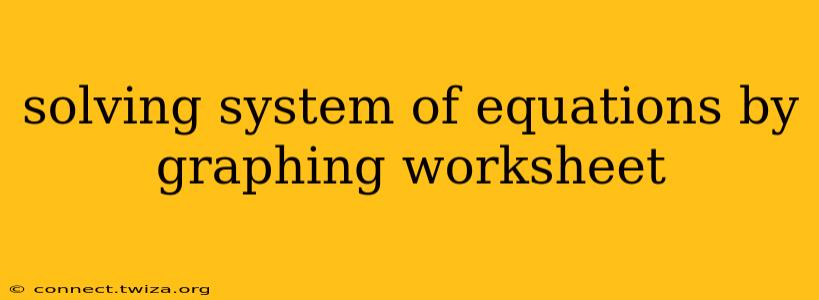Solving systems of equations by graphing is a fundamental concept in algebra. This method allows you to visually determine the solution(s) where two or more lines intersect. While it's not always the most precise method for complex systems, graphing provides a valuable understanding of the relationships between equations and their solutions. This worksheet guide will walk you through the process step-by-step, addressing common questions and challenges.
Understanding Systems of Equations
A system of equations is a collection of two or more equations with the same variables. The solution to a system is the point (or points) that satisfies all equations simultaneously. Graphically, this is represented by the intersection point(s) of the lines representing each equation.
Let's consider a simple example:
- y = x + 2
- y = -x + 4
These two equations represent two straight lines. Solving the system means finding the point where these lines intersect.
Step-by-Step Guide to Solving by Graphing
-
Graph each equation: The easiest way to graph a linear equation is to find the x and y intercepts. To find the x-intercept, set y=0 and solve for x. To find the y-intercept, set x=0 and solve for y. Plot these points and draw a straight line through them.
-
Identify the intersection point: Once both lines are graphed, look for the point where they intersect. This point represents the solution to the system of equations. The x-coordinate is the x-value of the solution, and the y-coordinate is the y-value.
-
Check your solution: Substitute the x and y values of the intersection point into both original equations. If the equations are true for both values, you have found the correct solution.
Types of Solutions
When graphing systems of equations, you can encounter three main scenarios:
- One unique solution: The lines intersect at exactly one point. This is the most common scenario.
- No solution: The lines are parallel and never intersect. This means the system is inconsistent, and there is no solution that satisfies both equations.
- Infinitely many solutions: The lines are coincident (they are essentially the same line). This means that any point on the line satisfies both equations.
Common Challenges and How to Overcome Them
1. Inaccurate Graphing: A slightly inaccurate graph can lead to an incorrect solution. Use graph paper and a ruler for precision. Consider using online graphing tools for more accurate representation, particularly when dealing with equations involving fractions or decimals.
2. Difficult-to-read intersection points: If the intersection point doesn't fall exactly on a grid point, it can be challenging to determine the precise coordinates. Use estimation, and remember that graphing provides an approximate solution. For greater precision, use algebraic methods to solve the system.
H2: What are the different methods for solving systems of equations?
Besides graphing, there are other methods to solve systems of equations:
- Substitution: Solve one equation for one variable and substitute it into the other equation.
- Elimination: Multiply equations by constants to eliminate one variable and solve for the other.
- Matrices: Use matrix operations to solve systems of equations, particularly efficient for large systems. Each method has its advantages and disadvantages depending on the specific equations in the system.
H2: How do I know if a system of equations has no solution?
A system of equations has no solution if the lines representing the equations are parallel. Parallel lines have the same slope but different y-intercepts. When you attempt to solve the system algebraically, you'll arrive at a contradiction (e.g., 0 = 5).
H2: How do I know if a system of equations has infinitely many solutions?
A system of equations has infinitely many solutions if the lines representing the equations are coincident (the same line). This means they have the same slope and the same y-intercept. When solving algebraically, you will end up with an identity (e.g., 0 = 0).
Practice Problems
Try solving these systems of equations by graphing:
-
y = 2x + 1 y = -x + 4
-
y = x - 3 y = x + 1
-
2x + y = 4 x - y = 1
This worksheet guide provides a solid foundation for understanding and solving systems of equations by graphing. Remember, practice is key to mastering this skill. Use graph paper, check your work carefully, and consider exploring alternative methods when graphing becomes less practical.
